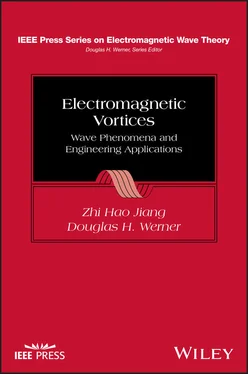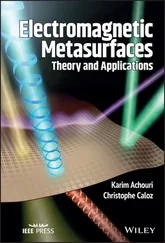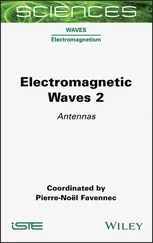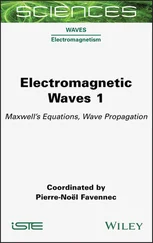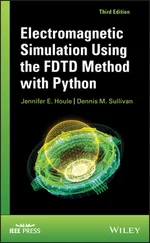1 ...8 9 10 12 13 14 ...18 
Figure 1.8 OAM possible communication links: (a) OAM to the conventional antenna. The figure of merit is the received power, which is calculated using the classical Friis transmission formula [26].
Source: Based on Friis [26]; (b) OAM to OAM antenna.
The figures of merit are the received power and the detected OAM mode purity, which are calculated using the generalized Friis transmission equation [27]. The OAM beam divergence poses a challenge for far‐field communication distances. A large receiving aperture is required.
Source: Based on Cho and Byun [27].
In the second scenario, two OAM antennas that are facing each other constitute the communication link. The transmitting antenna generates an OAM beam of mode number l , which propagates in free space and is detected by another OAM antenna. The performance of this particular link is characterized by the received power (i.e., signal‐to‐noise ratio) as well as the detected OAM mode purity; a generalized Friis transmission equation that accounts for both the received power and the mode purity has been developed in [27]. A large receiving aperture is required for two reasons. First, a limited aperture would lead to power loss due to the central intensity drop of nonzero OAM modes. A series of recent studies has shown that the power loss penalty increases for larger OAM modes (larger OAM modes diverge more rapidly with propagating distance) [28–31]. Second, a substantial portion of the transmitted wavefront should be captured at the receiver endpoint to detect the OAM phase information and accurately estimate the mode number l .
An OAM‐based communication link presents unique challenges that are related to the OAM beams’ inherent characteristics, such as the beam divergence. Ideally, a large and perfectly aligned receiving aperture would capture the full OAM beam, as shown in Figure 1.9. The requirement to collect enough power of the divergent OAM beam with a very large aperture (compared to wavelength) significantly limits the achievable distance of OAM communication links [32], especially for the radio frequencies, where the wavelengths are longer compared to optical frequencies. In particular, Refs. [33–35] question the possibility of using OAM antennas in long‐distance communication links. They highlight that to achieve a realistic signal‐to‐noise ratio at the receiver endpoint, the physical size of the receiving antenna becomes impractical. The impact of the finite receiving aperture size and the misalignment (lateral and angular) between the transmitter and the receiver on the performance of an optical OAM communication link was investigated in [36]. In principle, when a finite‐size receiving aperture is used, power loss of the detected mode occurs (see Figure 1.9). Receiving an OAM beam with misalignment would cause power leakage in the neighboring modes and inter‐mode crosstalk [37].
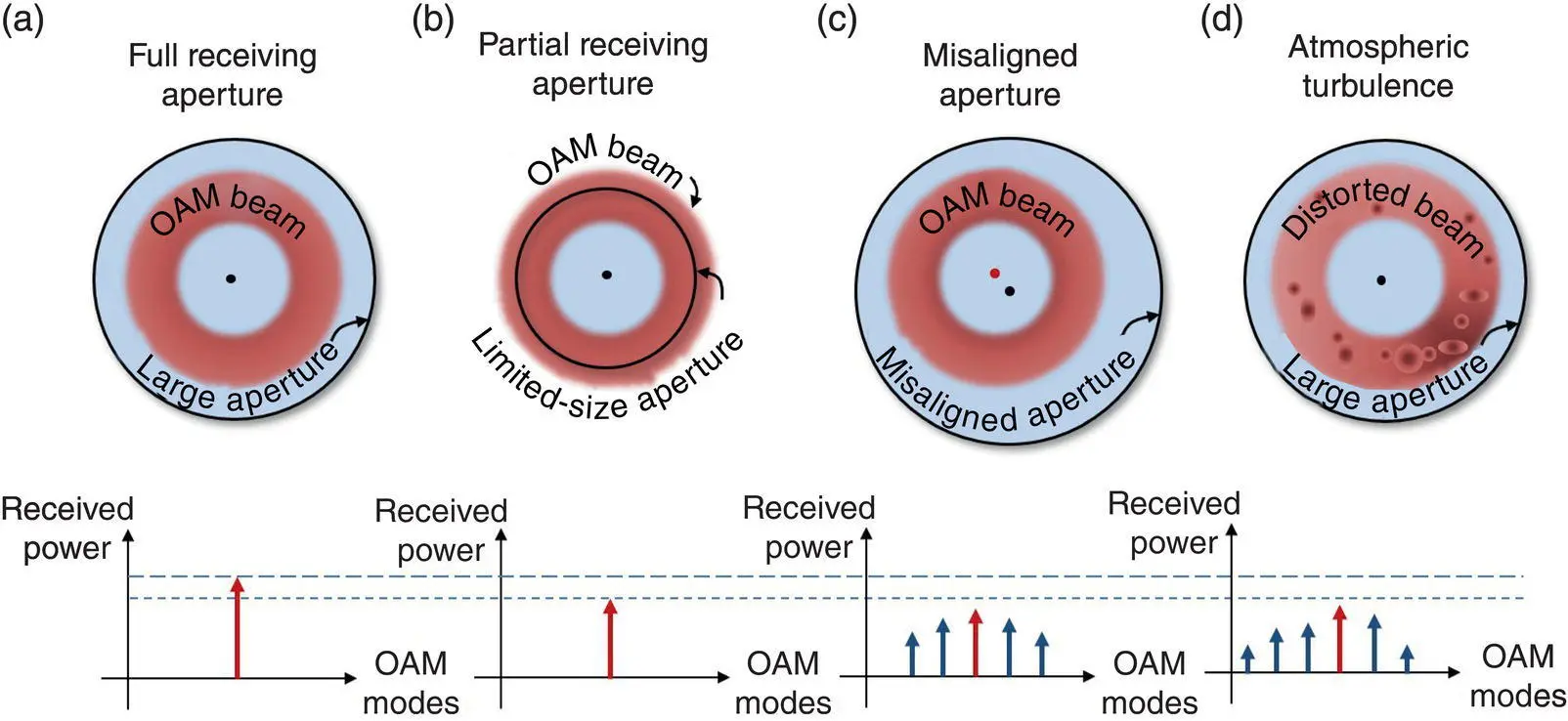
Figure 1.9 OAM communication challenges: (a) receiving with a perfectly aligned and full receiving aperture, (b) receiving with a limited‐size aperture causes power loss of the detected mode, (c) receiving with a misaligned aperture, and (d) atmospheric turbulence causes power leakage in adjacent modes.
Another critical challenge for a practical OAM‐communication link is the atmospheric turbulence. Temperature and pressure fluctuations in the atmosphere result in spatial changes in the refractive index. The propagation of optical OAM beams in the turbulent atmosphere has been numerically modeled in [38–40] and experimentally investigated in [41–45]. The main conclusion is that atmospheric turbulence leads to wavefront distortion and significant system performance degradation. Atmospheric turbulence impacts more OAM beams in optical frequencies than radio frequencies [32]. As the turbulence strength increases, the power of the transmitted OAM mode starts to leak to neighboring modes and tends to be equally distributed among modes for strong turbulence [46].
The multipath propagation phenomenon in wireless communication links using OAM is another factor that affects the system performance. The analysis, simulations, and measurements of multipath effects in a millimeter‐wave communication link using OAM multiplexing at 28 GHz were presented in [47]. A schematic of multipath effects of an OAM channel caused by specular reflection from a parallel ideal reflector (ground plane) that is placed at distance h below the transmitting antenna is shown in Figure 1.10. From image theory, the reflected beam can be seen as an OAM beam of an opposite mode number (the reflection changes the sign of the OAM mode) that is placed at a distance h below the ground plane. As a result, the receiver antenna will not only receive an OAM beam with an OAM number of l from the original transmitter but also a reflected beam with an OAM number of − l from an offset link. Ref. [47] showed that an OAM channel with a higher OAM number l tends to suffer more from both strong intra‐channel crosstalk and strong inter‐channel crosstalk with other OAM channels.
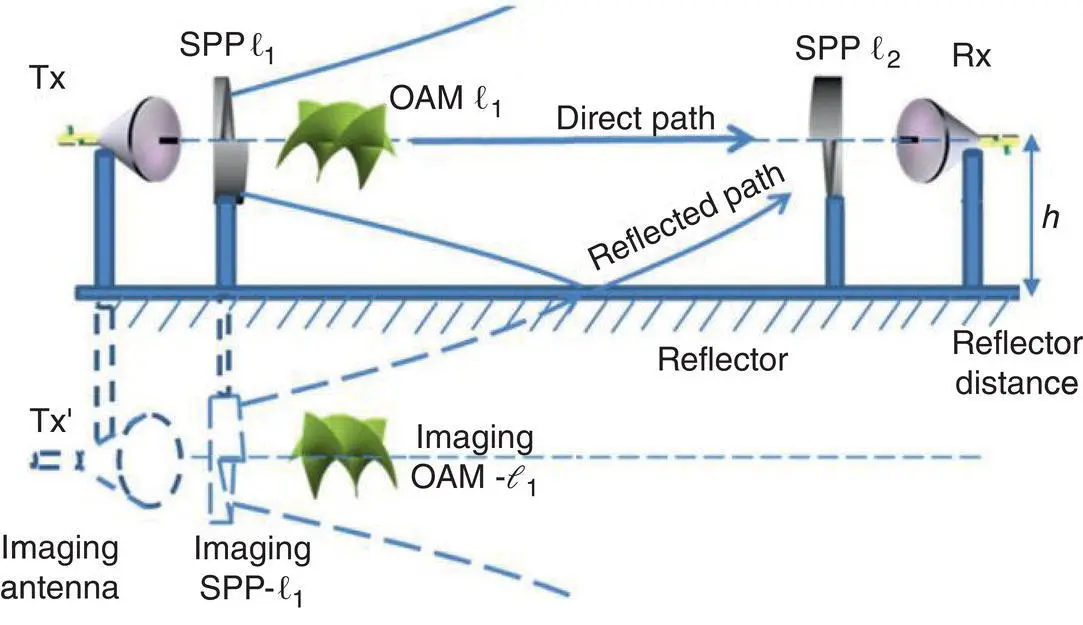
Figure 1.10 A schematic of multipath effects of an OAM channel caused by specular reflection from a parallel ideal reflector (ground plane) that is placed at distance h below the transmitting antenna. The receiver antenna will not only receive an OAM beam with an OAM number of l from the original transmitting antenna but also a reflected beam with an OAM number of − l from an offset link.
Source: Yan et al. [47]; © 2016 Springer Nature. Licensed under CC BY‐4.0.
1.3.2 OAM Emerging Applications and Perspectives
1.3.2.1 Free‐space Communications
One application that may take advantage of the OAM cone‐shaped pattern is the local satellite‐based navigation and guidance system that serves moving vehicles. For such an application, the satellite is usually placed in a geostationary orbit and employs a contour beam that covers a certain geographical area [5], as shown in Figure 1.11. An antenna is mounted on the moving vehicle and is circularly polarized to alleviate multipath propagation problems caused by reflections from building walls and the ground surface. For the vehicle to continuously communicate with the satellite, a directivity of at least 3 dB in the direction of the satellite should be maintained regardless of the orientation of the vehicle [48].

Figure 1.11 A satellite‐based, geostationary navigation and guidance system that serves moving vehicles. OAM antennas with cone‐shaped patterns are proposed to be mounted on the vehicle [5]. The same signal‐to‐noise ratio is achieved regardless of the orientation of the vehicle because of the horizontally omnidirectional radiation pattern.
Source: Modified from Veysi et al. [5].
Several antenna designs have been suggested for communications between moving vehicles on the earth and geostationary satellites. One possible solution is an antenna with a pencil‐beam pattern that sweeps out a cone in space. The beam pattern scans to continuously point toward the satellite so that uninterrupted vehicle‐to‐satellite communication is achieved. This solution increases the cost of the antenna system since the tracking of the satellite is needed. An alternative approach is an antenna with a fixed cone‐shaped pattern, with the peak of the cone (denoted by the cone angle θ cin Figure 1.11) pointing toward the satellite. The same signal‐to‐noise ratio is achieved regardless of the orientation of the vehicle because of the horizontally omnidirectional radiation pattern. The latter approach does not require the tracking of the satellite, thus the antenna cost and complexity are reduced. Among various antennas with conical patterns that have been proposed for vehicle‐to‐satellite communications [48–51], an OAM antenna is a powerful apparatus that systematically generates a cone‐shaped pattern with high‐azimuthal symmetry [5].
Читать дальше
